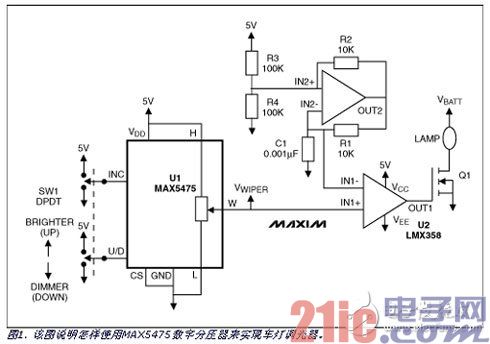
Privacy statement: Your privacy is very important to Us. Our company promises not to disclose your personal information to any external company with out your explicit permission.
introduction
This article refers to the address: http://
In automotive and other lighting applications, it is often necessary to adjust the interior lighting. Using a mechanical voltage divider to achieve this function wastes power, and using a mechanical voltage divider to do this wastes power, is relatively inefficient, and has durability issues. The design in this application note uses the user's familiarity with the up/down control keys in the cellular phone and uses a low-cost digital potentiometer (digital voltage divider) to achieve strong and weak dimming control. The use of a digital voltage divider not only avoids the inefficiencies and mechanical durability of the mechanical divider, but also saves power and increases efficiency.
I headlight dimming solution
This design uses a nonvolatile digital voltage divider to establish the dimming threshold and a separate pseudo sawtooth oscillator for pulse width modulation (PWM) lighting control. The MAX5475 (U1) is a 32-tap nonvolatile digital voltage divider with an end-to-end resistance of 100k. The design uses a double pole double throw (DPDT) switch (SW1) to control the digital voltage divider. One end controls the U/D pin of the MAX5475 and the other end controls the INC pin. Therefore, pressing the switch in the "up" direction produces a high-to-low transition on the INC, incrementing the digital voltage divider; pressing the switch in the "down" direction decrements the digital voltage divider. The non-volatile nature of the MAX5475 brush position allows the dimming setting to be maintained even when the power is not supplied.
The digital voltage divider brush (VWIPER) is fed into the inverting input of the LMX358 (U2) dual op amp (op amp). It is then compared to a pseudo sawtooth wave generated at the other input of the dual op amp. Basically, the sawtooth ramp produces a PWM drive for FET Q1. Increasing VWIPER increases the duty cycle, FET turn-on time, and lamp brightness. (In practice, since the lamp includes an RC charging network consisting of R1 and C1, it is non-linear. However, during the charging interval, the waveform is well suited for low-cost duty cycle control). A logic level n-channel enhancement FET drives the lamp. Q1 should be selected based on the load requirements of the lamp.

To generate a sawtooth oscillator, the LMX358 should be configured as shown in Figure 1. Resistors R2, R3, and R4 generate oscillation hysteresis. With a 5V input, the amplifier's IN2+ input triggers between 0.41V and 4.55V. Note that lowering the value of R2 will increase the range of rise; increasing the value of R2 will decrease the range of rise. The design uses a 10k R2 to achieve its rise range within the accuracy of the MAX5475 digital voltage divider. When the capacitor C1 is discharged between the 0.41 and 4.55V thresholds through the resistor R1, a rising ramp is generated.

to sum up
This application note describes how to implement PWM dimming control using a low cost digital voltage divider. The design uses a similar up/down control button in the cellular phone, which eliminates the need for a microprocessor and reduces the cost by using the familiar up/down control functions. The use of mechanical voltage dividers for dimming the lights is not only inefficient but also has durability issues. This design uses digital voltage dividers to increase efficiency and save power.
November 21, 2022
September 29, 2022
August 10, 2024
April 30, 2024
September 29, 2024
November 18, 2023
Gửi email cho nhà cung cấp này
November 21, 2022
September 29, 2022
August 10, 2024
April 30, 2024
September 29, 2024
November 18, 2023

Privacy statement: Your privacy is very important to Us. Our company promises not to disclose your personal information to any external company with out your explicit permission.

Fill in more information so that we can get in touch with you faster
Privacy statement: Your privacy is very important to Us. Our company promises not to disclose your personal information to any external company with out your explicit permission.